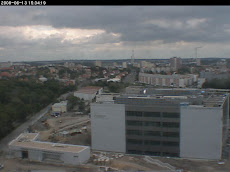
The first morning in Istanbul (Saturday) we started off by visiting the Basilica Cistern. The cistern is in the center of the historic section of old Istanbul called Sultanahmet. Many of the other main sites are also in this area - the Blue Mosque, the Hippodrome, the Ayasofia and Topkapi Palace. Our hotel was just a 5 minute walk to the Hippodrome, which is really a long and narrow park with the other sites around it.
When I was here in 1993 I stayed in a cheap hotel very close to the Hippodrome. I remember visiting the Basilica Cistern and that it was just a block away. When we were exploring the neighborhood I think I found the hotel that I stayed in then, and the carpet shop where I bought the two beautiful wool carpets that I still have today.
Anyway, I remember the cistern as being a great palce to see so we went there first.
From wikipedia:
The Basilica Cistern (Turkish: 'Yerebatan Sarayı' or 'Yerebatan Sarnıcı'), is the largest of several hundred ancient cisterns that still lie beneath the city of Istanbul, former Constantinople, Turkey.
The cistern, located in the historical peninsula of Istanbul next to the Hagia Sophia, was built during the reign of emperor Justinian I in the 6th century, the age of glory of Eastern Rome, also called the Byzantine Empire.
This cathedral-sized cistern is an underground chamber of 143 by 65 metres, capable of holding 80,000 cubic metres of water. The large space is broken up by a forest of 336 marble columns each 9 metres high. The columns are arranged in 12 rows each consisting of 28 columns. The capitals of the columns are mainly Ionic and Corinthian styles, with the exception of a few Doric style with no engravings. According to ancient historians, emperor Constantine had already built a basilica and cistern on the same spot. As the demand for water grew, emperor Justinian enlarged the cisterns and incorporated the basilica.
The cistern is surrounded by a firebrick wall with a thickness of 4 meters and coated with a special mortar for waterproofing. The cistern's water was provided from the Belgrade Woods—which lie 19km north of the city—via aqueducts built by the emperor Justinian.
The cracks and the columns were repaired in 1968. Having been restored in 1985 by the Istanbul Metropolitan Museum, the cistern was once again opened to the public on 9 September, 1987.
And this, from another web site - guideistanbul.net:
The interior of Underground Cistern is breathtaking. It is 138 m, 452 ft long by 65m, 213 ft wide. There are 336 columns in the cistern. Most of the column capitals are either in Corinthian or Doric Style. At the far end of the Cistern, there are two heads of Medusa which are put upside down or side ways. The Medusa Heads are taken from an ancient Pagan site but they complement the pillars very beautifully and add a different taste to the building.
Because of its magic atmosphere and great acoustics, this cistern is now hosting many Classical Music Concerts. There is also a little café which one can sip his or her coffee and enjoy this unique building. On the way to the exit, there are two small bookshops which is full of postcards and informative books as well as some silver jewelry.
We visited at about 9:00 in the morning. I think the restaurant in the cistern is used only for specially catered occassions.
A couple of other facts about the cistern: it covers an area of 2.4 acres and can hold 21 million gallons of water (or 80,000 cubic meters).
Here is Noah with one of the two medusa heads (referenced above). One is upside down and one is sideways (this is the sideways one). It is believed that they were placed this way by design, but no one is sure why.
Thursday, April 17, 2008
The Basilica Cistern...
Subscribe to:
Post Comments (Atom)


No comments:
Post a Comment